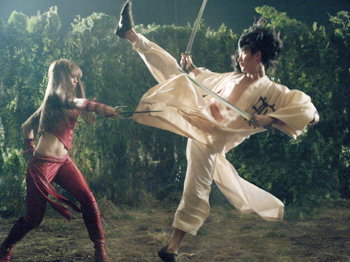![[Metroactive Movies]](/movies/gifs/movies468.gif)
[ Movies Index | Show Times | Silicon Valley | Metroactive Home | Archives ]
Talk to the Foot: Jennifer Garner parries the pedal thrusts of Will Yun Lee in 'Elektra.'
Elektra Frying
The screen version of 'Elektra' brings to an end a tangled skein of superhero lineage
By Richard von Busack
JANUARY is the dead zone for movies. The industry collapses into a heap right after the Oscars-qualification derby, pausing only to regroup at Sundance. Elektra, a sequel to 2003's Daredevil, is one studio's vain hope for a cold-weather hit.
If you missed Daredevil, Ben Affleck played Marvel Comics' vigilante, whose sensory powers were augmented after he was blinded by a splash of radioactive waste. Playing blind was perfect for Affleck, as it allowed for his customary inability to express feeling through his eyes.
In Elektra, the Daredeviless sequel by Rob Bowman (The X-Files), Daredevil's ex, the omnipotent female assassin Elektra (Jennifer "Alias" Garner), combats an ancient group of evildoers called "The Hand." When she fails, she's Yoda-ed by Terence Stamp, playing Elektra's ex-teacher "Stick." This shot-in-Vancouver actioner is short on the martial arts and long on the reparenting of Elektra's surrogate inner child, Abby (Kirsten Prout). Garner grieves--mourning does not become this Elektra.
Along with her iconic minitrident, or sai, the scarlet-clad killer's weapon is kimagure, the ability to predict the future. You, too, Grasshopper, will have this kimagure while watching Elektra: every line, every plot twist, every digitally processed so-called fight scene will be easily foretold.
In the comic books, Daredevil was an acrobat, racing along the roofs, leaping from the water tanks atop the vintage buildings in Manhattan, springing off the arced stanchion of streetlights, as if off a diving board. Daredevil was bedeviled by the promise he made to his late father, a murdered boxer, who made him swear never to be a fighter. This situation was worked over the years into a raging Freudian issue that immobilized out hero whenever the plot needed thinning.
Gadgetless and capeless, the comic-book Daredevil was an inferior Batman—a B-level item as opposed to the flashier Marvel figures like Spider-Man or the Fantastic Four, who have their own movie coming out this July.
The early 1980s were the comic book's vintage years, assembled by the team of editor Denny O'Neil, inkers Klaus Janson and Terry Austin and a 22-year-old cartoonist named Frank Miller.
Miller created Elektra—Daredevil's wrong-side-of-the-law love interest—and killed her off, too. Though Miller later worked on graphic novels such as Elektra Assassin and Elektra Lives Again, the particularly guilty Daredevil was all the worse for the loss of his Elektra. Unbeknownst to him, she had been brought back from the dead. As Miller's story line ended, Elektra was headed through the ice to a Lost Horizons monastery deep in the mountains.
Leaving Daredevil some three years after he began, Miller went on to create The Dark Knight Returns in 1984. The hit graphic novel energized an interest in Batman and directly led to the movie version. Miller's later series Batman: Year One is the nugget of idea behind this summer's "action-movie event" Batman Begins. Moreover, Robert Rodriguez's film of Miller's Mickey Spillane-style graphic-novel series Sin City has been given a February release date.
Daredevil helped prepare the American public for graphic novels. Miller's art and writing proved that even a 60-cent comic book could have aesthetics. The influences were obvious—Jim Steranko's term on the psychedelic Nick Fury and the experiments in lettering and framing created by the late Will Eisner.
Yet Miller brought plenty of his own innovations. He could be minimalist, drawing slatted windows as sharp and enigmatic as I Ching hexagrams. The cartoonist reveled in negative space, leaving room for blushing watercolor clouds as tinted as Japanese prints.
Most importantly, long before Tarantino's heyday, Miller was rabid for martial-arts movies. He anticipated the Asian influence on American action cinema. This was years before Hong Kong movies made their impact, years before the importing of John Woo, Ringo Lam and the influential wire-worker Corey Yuen (The Matrix).
This hardly-worth-it movie version of Elektra closes a chapter. Similarly, Miller's Dark Knight 2 graphic novel last year was careless and disappointing. Miller's sequel could be summed up by an interview he did with journalist Charles Brownstein: "Those of us who worked to test the boundaries of what a superhero comic book could do ... we pushed against the old walls, and they fell—but nothing much has been built to replace them." "DK2"—decay, indeed—couldn't be called part of the rebuilding process.
It's Hollywood's loss that it didn't have enough foresight to figure out what to do with Miller in the beginning of his career. Some foresight could have resulted in a Daredevil movie years before 1989's Batman. If the film world had been alert, it could have begun the new style of comic-book movie years earlier than Batman—an era of costumed heroes in a cold film noir world, not a three-color one.
[ Silicon Valley | Metroactive Home | Archives ]
![]()

Photograph by Doane Gregory
Send a letter to the editor about this story to letters@metronews.com.
From the January 19-25, 2005 issue of Metro, Silicon Valley's Weekly Newspaper.